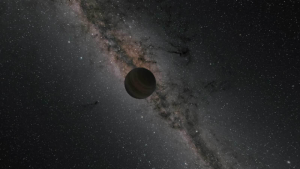
I’ve said it before, and I’m sure I’ll say it again – our understanding of the solar system advances at the pace of technology. As our processing power grows, we are able to do more and more complex calculations, and the spherical cows we had to assume to make the math easier are now getting replaced with real physics. In general, we don’t actually worry about cows unless atmospheric science — like the study of tornadoes and the air dynamics of cows — are being contemplated.
Planetary scientists are fortunate, as they often start with spherical planets on nearly circular orbits. Working from the solar system we see today, researchers can run our solar system backwards and forwards, modelling both how our solar system evolved to its present structure and where planets might move in the future.
And thanks to new computer models by Nathan Kaib and Sean Raymond, we get to see just how not-circular those orbits can get when stars pass a little too close to our solar system. Running models that stepped forward through the next 5 billion years of our solar system, they looked to see what short-term and long-term effects the gravity of a passing star might have on our worlds.
And the effect wasn’t at all what I expected.
I’m just going to read an excerpt from the paper’s abstract for you. “Our planets and Pluto are significantly less stable than previously thought. Field stars transform Pluto from a completely stable object over 5 Gyrs to one with a ∼5% instability probability. Furthermore, field stars increase the odds of Mercury’s instability by ∼50%–80%. We also find a ∼0.3% chance that Mars will be lost through collision or ejection and a ∼0.2% probability that Earth will be involved in a planetary collision or ejected.”
My gut instinct had told me Pluto and other outer dwarf worlds were the most likely to get yeeted out of the Solar System. Turns out, small tweaks to an inner world like Mercury are massively magnified by the influence of the Sun and other worlds. It all comes down to potential. If you blow on a marble at rest on a barely sloped surface, very little will happen. If you do the same thing to a marble on a steep surface, you could send it on a wild journey.
In our solar system, a passing star’s gravity is that breath of force that can wreak havoc on worlds. … at least sometimes… of the 1000 simulations that ran with close passages by a star, only 5 of the simulations yielded 1 or more planets.
Right now, there are no stars known to be on collision courses with our Solar System. The probability of a close passage over the next 5 billion years is low, so in all likelihood, none of these terrible possibilities will become a terrible reality in our solar system. But our Solar System is just one of billions, and somewhere out there, this will happen to someone… so if you’re looking for a topic for your next sci-fi story… here you go.
This work appears in the journal Icarus and was funded by the NASA Solar System Workings program and Programme Nationale de Planetologie in France and utilized services funded by the National Science Foundation.
